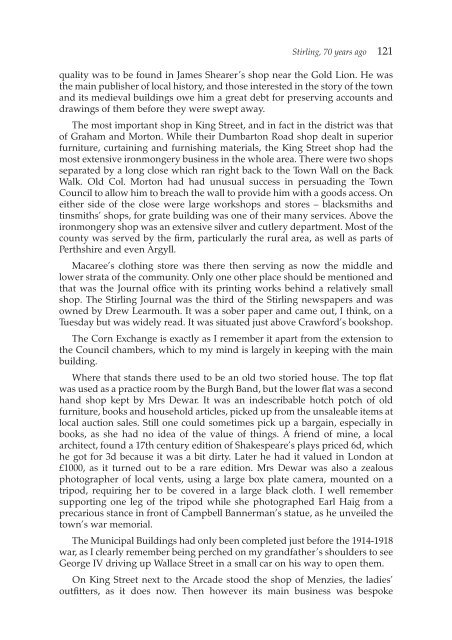the Forth Naturalist Historian - Forth Naturalist and Historian ...
the Forth Naturalist Historian - Forth Naturalist and Historian ...
the Forth Naturalist Historian - Forth Naturalist and Historian ...
Create successful ePaper yourself
Turn your PDF publications into a flip-book with our unique Google optimized e-Paper software.
Stirling, 70 years ago 121<br />
quality was to be found in James Shearer’s shop near <strong>the</strong> Gold Lion. He was<br />
<strong>the</strong> main publisher of local history, <strong>and</strong> those interested in <strong>the</strong> story of <strong>the</strong> town<br />
<strong>and</strong> its medieval buildings owe him a great debt for preserving accounts <strong>and</strong><br />
drawings of <strong>the</strong>m before <strong>the</strong>y were swept away.<br />
The most important shop in King Street, <strong>and</strong> in fact in <strong>the</strong> district was that<br />
of Graham <strong>and</strong> Morton. While <strong>the</strong>ir Dumbarton Road shop dealt in superior<br />
furniture, curtaining <strong>and</strong> furnishing materials, <strong>the</strong> King Street shop had <strong>the</strong><br />
most extensive ironmongery business in <strong>the</strong> whole area. There were two shops<br />
separated by a long close which ran right back to <strong>the</strong> Town Wall on <strong>the</strong> Back<br />
Walk. Old Col. Morton had had unusual success in persuading <strong>the</strong> Town<br />
Council to allow him to breach <strong>the</strong> wall to provide him with a goods access. On<br />
ei<strong>the</strong>r side of <strong>the</strong> close were large workshops <strong>and</strong> stores – blacksmiths <strong>and</strong><br />
tinsmiths’ shops, for grate building was one of <strong>the</strong>ir many services. Above <strong>the</strong><br />
ironmongery shop was an extensive silver <strong>and</strong> cutlery department. Most of <strong>the</strong><br />
county was served by <strong>the</strong> firm, particularly <strong>the</strong> rural area, as well as parts of<br />
Perthshire <strong>and</strong> even Argyll.<br />
Macaree’s clothing store was <strong>the</strong>re <strong>the</strong>n serving as now <strong>the</strong> middle <strong>and</strong><br />
lower strata of <strong>the</strong> community. Only one o<strong>the</strong>r place should be mentioned <strong>and</strong><br />
that was <strong>the</strong> Journal office with its printing works behind a relatively small<br />
shop. The Stirling Journal was <strong>the</strong> third of <strong>the</strong> Stirling newspapers <strong>and</strong> was<br />
owned by Drew Learmouth. It was a sober paper <strong>and</strong> came out, I think, on a<br />
Tuesday but was widely read. It was situated just above Crawford’s bookshop.<br />
The Corn Exchange is exactly as I remember it apart from <strong>the</strong> extension to<br />
<strong>the</strong> Council chambers, which to my mind is largely in keeping with <strong>the</strong> main<br />
building.<br />
Where that st<strong>and</strong>s <strong>the</strong>re used to be an old two storied house. The top flat<br />
was used as a practice room by <strong>the</strong> Burgh B<strong>and</strong>, but <strong>the</strong> lower flat was a second<br />
h<strong>and</strong> shop kept by Mrs Dewar. It was an indescribable hotch potch of old<br />
furniture, books <strong>and</strong> household articles, picked up from <strong>the</strong> unsaleable items at<br />
local auction sales. Still one could sometimes pick up a bargain, especially in<br />
books, as she had no idea of <strong>the</strong> value of things. A friend of mine, a local<br />
architect, found a 17th century edition of Shakespeare’s plays priced 6d, which<br />
he got for 3d because it was a bit dirty. Later he had it valued in London at<br />
£1000, as it turned out to be a rare edition. Mrs Dewar was also a zealous<br />
photographer of local vents, using a large box plate camera, mounted on a<br />
tripod, requiring her to be covered in a large black cloth. I well remember<br />
supporting one leg of <strong>the</strong> tripod while she photographed Earl Haig from a<br />
precarious stance in front of Campbell Bannerman’s statue, as he unveiled <strong>the</strong><br />
town’s war memorial.<br />
The Municipal Buildings had only been completed just before <strong>the</strong> 1914-1918<br />
war, as I clearly remember being perched on my gr<strong>and</strong>fa<strong>the</strong>r’s shoulders to see<br />
George IV driving up Wallace Street in a small car on his way to open <strong>the</strong>m.<br />
On King Street next to <strong>the</strong> Arcade stood <strong>the</strong> shop of Menzies, <strong>the</strong> ladies’<br />
outfitters, as it does now. Then however its main business was bespoke



